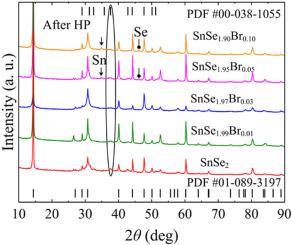Journal of Solid State Chemistry ( IF 3.2 ) Pub Date : 2020-05-24 , DOI: 10.1016/j.jssc.2020.121468 Ming Liu , Jingjing Zhang , Jian Xu , Baofu Hu , Bingguo Liu , Ke Sun , Yang Yang , Jian Wang , Baoli Du

|
SnSe2 compound, closely related to the well-known SnSe thermoelectric material, is a layered compound displaying strong anisotropic transport properties and intrinsically low lattice thermal conductivity. SnSe2 is dimorphic, which has a well-defined hexagonal structure (JCPDS #01-089-3197, S-3197) and an unidentified structure described by JCPDS #00-038-1055. In this study, Br-doped SnSe2 with both entangled phases were prepared by a melting and hot-pressing route. The evolution of phase structure with temperature was recorded by two cycles of DSC measurement and XRD. A complex, partly kinetically controlled phase transition between two structures was observed. SnSe2 is stable only with coexistence of the two phases. By substituting Se with Br, both carrier concentration and Hall mobility are improved, along with the enhanced stability of the hexagonal structure S-3197. Meanwhile, an abnormal high thermal conductivity was discovered in Br-doped polycrystalline samples compared with both pristine SnSe2 single crystal and non-doped polycrystalline samples, which is contradicted to the thumb of law that the “perfect” single crystal free of boundary scattering should possess a maximum lattice thermal conductivity, and that the doped samples should have a lower lattice thermal conductivity due to the point defect scattering aroused by dopant. The results suggest that intrinsic defects within grains, such as interstitial atoms, vacancies, and antisite defects, have much stronger scattering effects on phonons, than the grain boundaries and point defects introduced by dopants in polycrystalline samples, as shown in well-studied SnSe compound.
中文翻译:

原始和掺Br的SnSe 2的相结构,相变和热电性能
与众所周知的SnSe热电材料密切相关的SnSe 2化合物是一种层状化合物,显示出强的各向异性传输性能和本质上较低的晶格热导率。SnSe 2是双晶的,具有明确的六边形结构(JCPDS#01-089-3197,S-3197)和JCPDS#00-038-1055描述的身份不明的结构。在这项研究中,通过熔融和热压路线制备了两个纠缠相的掺Br的SnSe 2。通过DSC测量和XRD的两个循环来记录相结构随温度的变化。观察到两个结构之间的复杂的,部分动力学控制的相变。锡硒2只有在两个阶段共存时才稳定。通过用Br取代Se,载流子浓度和霍尔迁移率均得到改善,同时六角形结构S-3197的稳定性得到提高。同时,与两种原始SnSe 2相比,在掺Br的多晶样品中发现了异常高的热导率。单晶和非掺杂多晶样品,这与法律观点相矛盾,即没有边界散射的“完美”单晶应具有最大的晶格热导率,而掺杂样品应具有较低的晶格热导率,这是因为掺杂剂引起的点缺陷散射。结果表明,晶粒内的固有缺陷(如间隙原子,空位和反位缺陷)对声子的散射效应要强于掺杂剂在多晶样品中引入的晶界和点缺陷,如经过充分研究的SnSe化合物所示。











































 京公网安备 11010802027423号
京公网安备 11010802027423号